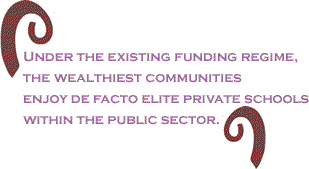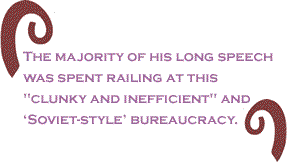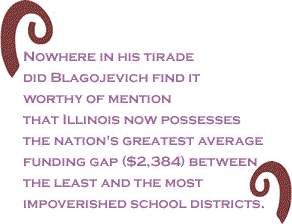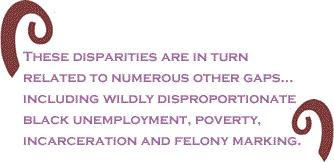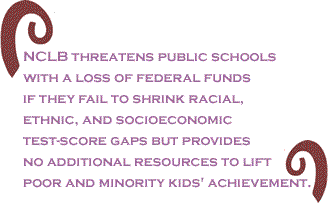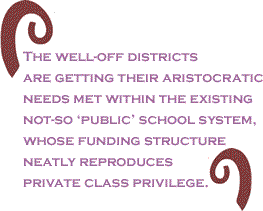
|
|||||||||||||||||||||
|
Sometimes the masters of policy and opinion speak most loudly through their silences. In such cases, it's what they fail to mention and what they choose to delete that says the most about who they are and what they are generally about: preserving privilege and power under the guise of populist concern for the people. Their omissions reflect their desire to suppress public consciousness and discussion of uncomfortable matters of race, class, and power that pose troubling questions about the content of American democracy. A Demon Agency and an Awful State Comparison An excellent case in point is provided by Illinois Governor Rod Blagojevich's recent (January 15, 2004) "State of the State Address," delivered to the Illinois Legislative Assembly. Consistent with the normal pattern, Blagojevich opened not with a serious discussion of social and economic conditions in the state but with his favorite recent policy accomplishments. After listing these off, however, the Governor moved quickly into a passionate attack on the state's "failing educational system," laying special blame on the Illinois State Board of Education (ISBE) – the apparent incarnation of modern political and policy evil this side of North Korea. "I am not satisfied with the state of education in Illinois," Blagojevich said. "While Illinois is blessed with thousands of good schools" and "with tens of thousands of smart, committed, dedicated teachers," he intoned, "our education system is still failing too many children." Blagoejevich recited horrible statistics from the depressing world of standardized testing: "38 percent of [Illinois] kids in the third grade can't read at the third grade level; 36 percent of eight graders do not meet eight grade reading standards; 41 percent of eighth graders cannot write on an eight grade level; 44 percent of eleventh graders can't meet basic reading standards; and 48 percent of eleventh grade students taking the ACT exam are not ready for college without having to repeat classes." Of special concern to the Governor was the terrible fact, repeated throughout his address, that only 46 cents of every Illinois education dollar goes to classroom instruction. Illinois ranks 16th in the nation, he noted, in the amount of money taxpayers invest in total per pupil spending. "But when it comes to how we spend that money, Illinois ranks only 40th in the nation when it comes to seeing that money invested in the classroom to teach our children. 40th in the nation! Thirty-nine other states do a better job than we do when it comes to how much money makes into the classroom. By comparison, California, for all of its problems, does a better job than we do. The Golden State, 53 percent of their education dollars on classroom instruction. Pennsylvania: 54 percent. New York: 60 percent on classroom instruction...the children deserve better," the Governor proclaimed. "The parents deserve better. The taxpayers deserve better."
What to do? "If we are really serious about fixing our schools," the Governor insisted, then Illinois must make "real, fundamental, systemic changes in the way we manage our schools, in the way we spend our education dollars, and in the way we hold people accountable for results." Illinois citizens and policymakers must break their attachment to the wrongheaded notion that "we're not spending enough money" on education. They should embrace, rather, structural reform in how existing education dollars are spent. And the main structural reform required, the Governor insisted, is abolition of the terrible Illinois State Board of Education (ISBE). The majority of his long speech was spent railing at this "clunky and inefficient" and "Soviet-style" bureaucracy, which he associated with all the standard problems that most enrage John Q. Taxpayer: bloat, over-regulation, waste, top-heaviness, and crippling inefficiency. The solution is not to raise or spend more money, Blagojevich argued, but to replace the burdensome ISBE with a state Department of Education under his control. Deleting "Savage Inequalities" in "How We Spend That Money" The precise extent to which the supposedly terrible, bloodsucking ISBE "handcuff's" Illinois education and "shortchanges children" remains unclear. The Governor never tried to substantiate the dark linkage he made between the demon agency, test scores, and the misapplication of school funding dollars.
Six other things, however, are quite evident indeed. First, the governor already possesses the right to appoint ISBE members and so has considerable control over that agency. Second, numerous factors (e.g., the age of Illinois schools buildings, the state's educational salary and wage structure and schools' investment in safety) would need to be included in any serious analysis of the 46-cents-on-classroom instruction figure. Third, children benefit significantly from numerous educational investments that do not go directly into classroom instruction – school heating systems, lunch programs, lead paint removal, transportation, and so on (Phil Kadner, "Governor Isn't Talking About the Other 54 Cents," Daily Southtown). Fourth, the governor could easily cut a number of key state agencies (for example the Illinois Tollway Commission or the Illinois Department of Corrections) in a serious campaign against bureaucratic bloat. Fifth, the Governor has a very selective, unduly class- and color-blind idea of the inter-state educational spending comparisons that should to be cited to elicit popular outrage, and the "systemic changes" that are required in "the way we spend our education dollars." Nowhere in his tirade did Blagojevich find it worthy of mention that Illinois now possesses the nation's greatest average funding gap ($2,384) between the least and the most impoverished school districts (Kevin Carey, The Funding Gap: Low-Income and Minority Students Still Receive Fewer Dollars in Many States, Washington DC: The Education Trust, 2003, p. 7), helping make it the one state to receive an 'F' for school-funding from the prestigious journal Education Week (see "Illinois Report Card”). This critical funding disparity translates into a revenue difference of $953, 600 between two typical elementary schools with 400 students (Carey, p. 9). At the extremes, per-capita education spending in the state varies from $18,000 to less than $5,000 per year (A+ Illinois Coalition, "About The Issues"). This sharp disparity, numerous reform groups point out, is the consequence of the state's extreme reliance on local property taxes to pay for public schools. State funding for K-12 education in Illinois covers just 38 percent of educating a student and Illinois ranks 48th among the 50 states in the share of total state school funding that comes from state government – another appalling inter-state comparison omitted from the Governor's address. Local property taxes account for nearly 60 percent of school expenses in Illinois, something that naturally tends to favor property-rich over property-poor districts (A+ Illinois, "About the Issues"). People of color tend to possess significantly less property wealth than whites, and Illinois happens to have the second most racially segregated public school system in the United States (John R. Logan, Jacob Stowell & Dierdre Oakley, Choosing Segregation: Racial Imbalance in American Public Schools, 1990-2000). Moreover, the state also happens to possess one of the nation's largest school-funding gaps between high-minority and low-minority school districts – another readily available inter-state comparison the Governor decided to leave out of his passionate educational oration. Sadly, the absolute amount and proportionate share of property tax payments required of individual local homeowners is often considerably higher in the less property-affluent districts. A homeowner in property-poor and very predominantly black East St. Louis pays $2,514 in education property tax to contribute to school funding in a district that spends $8,435 in operating expenses on each student. Taxpayers get a significantly higher bang for their public-educational buck in very affluent and predominantly white Lake Forest, Illinois. Homeowners there pay $454 in property taxes to support an $18,189 operating expense per pupil! (A+ Illinois, "About the Issues"). Welcome to "savage inequality," Jonathan Kozol's term to describe school-funding and related school-quality disparities in the United States. Who "the System Fails" Most
Sixth, the governor has a very selective, unduly class- and color-blind conception of which students exactly Illinois education is most especially failing. This regressive, racially disparate system of school funding is certainly related to the fact that Illinois boasts the nation's largest student test-score gap between wealthy and impoverished students – another inter-state comparison that did not elicit gubernatorial indignation. A recent report by Dr. Glenn McGee, superintendent of an exceedingly affluent school district north of Chicago, shows that poor kids are especially victimized by school failure measured by the admittedly problematic standard measure (standardized test scores). Less than half of the state's children who come from low-income families, McGee found, meet the standards set by the pedagogically counter-productive, reactionary, and shame-based testing regimen, meaning that nearly 400,000 Illinois non-affluent boys and girls are "struggling in school." About 30,000 out of 40,000 eleventh grade students from low-income families do not meet state standards in mathematics and science. In the state's Prairie State Examination (PSE), just 17.3% of students in the high poverty schools met the state's basic math standards. For the PSE as a whole, McGee notes, "20.5% of students in the high poverty schools meet or exceed state standards compared to almost 57% of students in schools enrolling fewer than half of their students from low-income families. Just 6.25 % of high poverty high schools have half their students meeting PSAE standards compared to 73.6 % of the other high schools. This," McGee, observes, "is an achievement gap." ("Closing Illinois' Achievement Gap: Lessons From the 'Golden Spike' High Poverty High Performing Schools.”) Another gubernatorial omission should come as no surprise: the racial and ethnic "achievement gap." In citing test scores as the critical evidence that public schools are failing Illinois children, the governor failed to mention that black and Latino children are especially "shortchanged" by his test-based criteria. In 2002, just 32 percent of the state's black students and 26 percent of its Hispanic students met or exceeded state reading standards, compared to 66 percent of white students. The racial and ethnic "achievement gap" was worse in math. (Human Relations Foundation and Hull House, Minding the Gap: An Assessment of Racial Disparity in Chicago – Education, 2003.) These disparities are in turn related to numerous other gaps that did not make it into the Governor's "State of the State" address, including wildly disproportionate black unemployment, poverty, incarceration and felony marking. Poor and Black Children Pushed Further Behind
Nearly ten years ago, The Chicago Urban League published a useful study of Illinois' school-funding regime. The report bore the interesting title "Preserving Privilege." The state's mid-1990s public educational financing system, The League showed, allocated a disproportionate share of taxpayer money to the very school districts that least needed assistance. That system failed to deliver adequate resources to districts with the greatest need. Per-student spending was considerably higher in districts where incomes, parental educational levels, and student test scores were already highest. The standard racial and ethnic corollaries held that school districts with majority-minority concentrations received considerably less than districts with majority white populations. Among the League's recommendations: reduce the school funding system's over-reliance on local property taxes, break the notion that local property wealth is the sole possession of local communities, and direct significant special additional resources to school districts that lack the special inherited privileges of high property wealth, high income, and high parental educational levels (Jim Lewis, Preserving Privilege: Inequity of the Illinois Education Finance System, Chicago: Chicago Urban League, 1995). Nearly ten years later, the majority of Illinois voters support these changes, even if they require a modest increase in personal income taxes, but the funding gap separating the state's rich from poor districts has expanded. This backwards movement stands in sharp opposition to the declared objectives and reporting requirement of the bipartisan, Bush-initiated "No Child Left Behind Act" (NCLBA). That miserable legislation threatens public schools with a loss of federal funds if they fail to shrink racial, ethnic, and socioeconomic test-score gaps but provides no additional resources to lift poor and minority kids' achievement and does nothing to compel states to confront their tendency (particularly exaggerated in Illinois) to distribute educational resources in a regressive, anti-democratic, and racially disparate fashion. De facto Private Schools
Is it any wonder that the predominantly Republican residents of Illinois' most affluent school districts show relatively slight enthusiasm for voucher-based school privatization, the heart of the national Republican Party's long-term education agenda? The well-off districts are getting their aristocratic needs met within the existing not-so "public" school system, whose funding structure neatly reproduces private class privilege without provocative resort to literal privatization. Under the existing funding regime, the wealthiest communities enjoy de facto elite private schools within the public sector. Accordingly, the false voucher "solution" to the crisis of public education is reserved for predominantly black and Hispanic inner-city schools, where public funding levels are nowhere near sufficient to meet the real costs of educating children who grow up in and around severe socioeconomic disadvantage and related racial and ethnic hyper-segregation. Faux Populism How sadly telling of American policymakers' long, dark, and bi-partisan reactionary drift to hear a Democratic governor delete any reference to this savage school funding inequality from a speech dedicated to advancing "systemic change" in how the state spends its educational dollars. How disturbing to see a leading elected official from the supposedly more progressive and social-democratic of the two relevant U.S. political parties mimic the faux populism of the Republicans, deflecting the media and populace from serious discussion of policy-deepened class and race injustices with a diversionary, superficially class- and color-blind tirade against concocted state-totalitarian evil. The state's citizens need to respond in a forthright fashion. Making the readily visible connections of class, race, place and school-funding policy, they need to call the governor on the reactionary folly of his big education speech. They need to join the fight for a public educational system worthy of its name. Paul Street ([email protected]) is an urban social policy researcher in Chicago, Illinois. His publications include "Too Many Children Left Behind: The Case Against School Vouchers," Z Magazine (September 2002): 46-50, and "'Class, Color, and The Hidden Injuries of Race," Z Magazine (June 2002): 39-42. |
February
19
2004 |
|||||||||
|
|||||||||
|
|
|||||||||
| Printer Friendly Version | |||||||||
 |
|||||||||
| |
|||||||||
| |
|||||||||






















